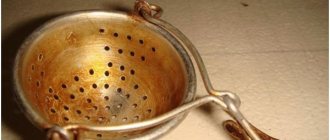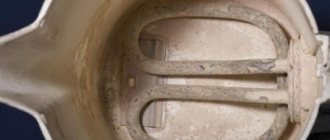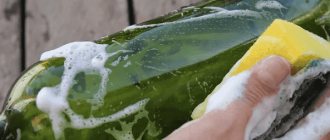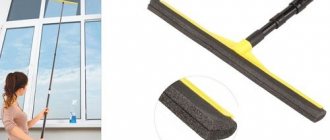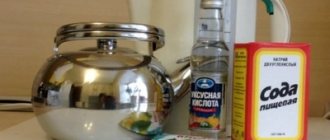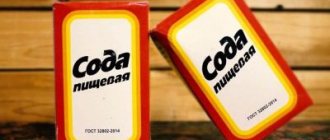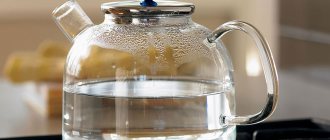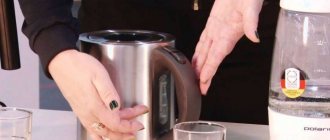Not everyone knows how to clean a teapot from tea deposits at home. Now there are dishwashers that do an excellent job of removing dirt. However, it is not recommended to clean the kettle manually, and it does not take much time. How to clean a teapot from tea deposits? Citric acid, salt and even Coca-Cola perfectly cleanse all impurities. All ingenious recipes are accessible and easy to use.
Lemon acid
A universal and safe cleanser. Citric acid cleanses any plaque well and fights unpleasant odors:
- Place 1 or 2 (depending on the degree of contamination) bags of citric acid on the bottom of the kettle.
- Pour boiling water so that the water completely covers all contaminated parts of the teapot.
- Leave for at least an hour or until the water has cooled completely.
- If the plaque is old, you can leave the solution overnight.
- After draining the water, rinse the kettle with boiling water several times. Rub particularly dirty areas with a sponge.
- Rinse with clean water and set to dry.
Causes
The leaves contain tannins. They give the drink bitterness and provide an astringent effect. Because of them, a cloudy film forms on the surface of the drink. It is not always visible, but over time it appears on the dishes.
When we drink, the mug tilts, a film settles on the cup and dries, becoming darker and thicker. This is the reason for traces that are difficult to wash off.
Tablets for cleaning dentures
These tablets are used to clean dentures from plaque and food debris, so they can also easily cope with tea plaque:
- Place 1-2 tablets on the bottom of the kettle and fill with boiling water (it is better to find out the exact ratio of the number of tablets and water by reading the instructions).
- Since the cleaning process will create a lot of foam, place the kettle in the sink or on a tray.
- After a few hours (if it’s heavily soiled, it’s better to leave it until the morning), drain the water, scrub the walls with a sponge and rinse well with water.
Why is it necessary to clean the teapot?
The strainer inside the teapot becomes very clogged with the coloring pigment - tannin, which is contained in tea, so it is especially noticeable how the tea leaves become cloudy in a glass teapot. Even thorough rinsing after each brew does little to help remove plaque. Therefore, brown marks remain on the inner walls and on the spout of the kettle. Over time, the strainer stops allowing tea leaves to pass through and requires careful cleaning, because the holes in it become very clogged.
Important! If your item is quite old and you don't really like the design, consider buying a new one. Perhaps it will give you more pleasure.
Read about how to choose a good quality teapot.
Of course, you can use an alternative method - use disposable tea bags for brewing. However, the quality of such a drink is not high, since production waste is usually used to make such teas, rather than high-quality leaves of tea trees.
Vinegar
Vinegar works well on old stains and unpleasant odors. When working with vinegar, be sure to wear gloves.
Pour table vinegar in a volume of no more than a quarter of the total volume of the teapot into the bottom of the teapot. Add hot water (not boiling water) on top. Cover with a lid and leave for at least 4-5 hours. Then drain the vinegar solution and rinse the kettle with water. You can additionally use dishwashing detergent. Leave it in the fresh air. After complete drying, there will be no trace of the smell of vinegar left.
How to clean a teapot from tea deposits
How to clean the inside of a stainless steel teapot from tea? How to wash glass or porcelain teapots? Conventional dishwashing detergents are not effective. But there is also salt, citric acid and ammonia. These inexpensive and simple means keep the teapot clean for a long time.
Lemon acid
The most common method for cleaning kitchen utensils. Citric acid removes dirt and odors. You need to pour boiling water into the kettle up to the lid. Pour citric acid into it and wait until the water cools down. If the teapot is very dirty, you can leave it this way overnight. Then pour out the water and wash off any remaining dirt with a sponge. You can throw lemon slices into the cleaning solution, then the kettle will not only become clean, but also acquire a lemon aroma.
Salt
Cleaning with salt is one of the most accessible methods of maintaining a teapot in its original form. To erase the plaque, salt is dissolved in boiling water and this water is poured into the kettle. You can also put a strainer there if it is not built into the kettle. Half an hour is enough for the plaque to leave the walls of the teapot, after which you need to pour out the solution and wipe the walls with a dishwashing sponge. Salt is a simple but very effective way to clean brown deposits from a kettle.
Vinegar
You can clean the teapot from tea deposits with vinegar. It is able to dissolve even the most stubborn stains from tea leaves. If acetic acid is used, then just pour it onto a sponge and wash the kettle with it. After cleaning, the kettle must be rinsed and the vinegar smell removed. If vinegar essence is used for cleaning, then you need to pour three-quarters of hot water and a quarter of the essence into the kettle. Cover the teapot with a lid and leave. After cleaning, the water should be drained and the kettle should be washed well with plain water.
Baking soda
Baking soda perfectly cleans dirty surfaces. To clean the teapot, you need to mix water with soda. Use the resulting slurry to carefully wash the inside of the kettle, without pressing the sponge too hard, otherwise you may damage the surface. Leave the teapot with soda for half an hour. After that, wash the kettle well and dry it. This cleaning method is not suitable for all teapots. The French press cannot be cleaned in this way, otherwise grains will clog the piston, after which it will become impossible to use this teapot.
Ammonia
This product will help remove all dirt and disinfect the surface. You need to prepare a solution of alcohol and water. Fill the kettle with this solution and leave it to soak. Then wash the kettle with regular dish soap, pour hot water over it and leave to dry. During work, you need to ventilate the room and use gloves.
Tablets for cleaning dentures
These tablets will perfectly clean the teapot from dirt and old plaque. Just throw a couple of tablets into the kettle and pour boiling water. The teapot with this solution should be left for some time. Afterwards, rinse the kettle with water and wash it with a sponge and a mild cleanser.
Coca Cola
Coca-Cola contains acid that will help get rid of all types of contaminants, including deposits from brewing. Pour Coca-Cola into the kettle so that it covers the entire dirty surface and leave for a while. If the kettle is very dirty, then Coca-Cola can be heated, but not boiled, and the hot liquid can be poured into the teapot. After several hours, drain the Coca-Cola and wash the kettle with clean water.
Baking soda
Baking soda is a universal cleaning and disinfectant for dishes. It cleans not only due to its chemical composition, but also due to its fine-grained structure, mechanically removing the top layer of dirt:
- Mix a small amount of baking soda with water to form a thick paste.
- Apply the paste to a sponge and lightly scrub all dirty surfaces of the kettle. Proceed carefully, without forceful pressure.
- Next, you can fill the kettle with hot water, or you can simply leave the soda paste on the walls for a while.
- Then rinse the teapot well and dry.
Can the teapot be washed in the dishwasher?
Washing dishes in the dishwasher is simple and convenient. Is it possible to wash a teapot in it? There are various options for kettles, most of which are not recommended for dishwasher cleaning. Such washing can ruin the teapot forever. You should read the instructions for the kettle before putting it in the washing machine. It’s better to spend a little time and wash the kettle by hand.
Coca Cola
Coca-Cola and similar drinks contain phosphoric acid, which can remove any type of plaque from many surfaces in a short time.
If the stains are light: pour Coca-Cola into the kettle and leave for several hours. Then drain and evaluate the result. The procedure can be repeated if necessary.
If there is a strong coating: heat the Coca-Cola without boiling and pour it into the kettle. Then proceed as in the first point.
After clearing the kettle of deposits, rinse it with water and set it to dry.
How to clean a teapot from plaque
Fans of real tea know that the teapot needs to be cleaned periodically, because your favorite drink leaves brown marks in it. They not only spoil the color of the tea, but also change its taste. You need to clean not only the teapot itself, but also the strainer, since a lot of tea residues also accumulate on it. Each type of teapot requires its own special care. You cannot clean a porcelain and glass teapot in the same way. Improper cleaning may inadvertently damage the product. How to wash off an unsightly plaque? There are several secrets. Baking soda, vinegar, and even some non-standard methods are used. These methods will also help solve the question of how to clean a teapot from scale.
How to clean the inside of a teapot from tea
How to clean a teapot from plaque and tea leaves inside? Here simple remedies available to everyone come into play - citric acid, vinegar, salt or ammonia. They need to be dissolved in boiling water and poured into a kettle. The teapot should stand for 2 hours; if the strainer is inside the teapot, it will automatically clean itself. Afterwards, you can drain the water from the kettle. If any dirt remains, you can remove it with a sponge, first dipping it in baking soda. It must be remembered that soda can cause minor damage to the dishes, so it is advisable to clean the kettle with soda with caution.
How to clean a tea strainer
When cleaning the kettle from plaque, the problem arises of washing small parts - the tea strainer. Often the strainer is very difficult to clean due to its small size. Cleaning this delicate product is possible using available products. You can dilute a couple of tablespoons of ammonia in a glass of cold water, put a strainer there and let it soak. After this, you can simply rinse it under running water. Another method is saline solution. It is enough to soak the strainer in it for half an hour, then rinse with water. If the strainer is clogged with tea leaves, it will be difficult to clean it even with the help of ammonia and salt. In this case, you can simply hold the sieve over a lit gas burner. There will be no harm to the metal strainer, but the remaining tea leaves will burn without a trace.
How to clean the teapot spout
Such a delicate part is sometimes difficult to wash. For example, how to clean the spout of a glass teapot? In any teapot, this part can be cleaned with a cotton swab; first you need to apply a mixture of soda and water to it. You can make ropes from an ordinary rag; they will also cope well with dirt.
Use of household chemicals
With the help of special means, you can destroy tea stains in a cup without any effort. Even old stains are easily removed thanks to the presence of active ingredients.
The most persistent and thick plaque can be removed using concentrated Faberlic gel (lemon and mint) with bioenzymes. Soft consistency is another advantage of such products. The surface is not scratched, but is gently cleaned.
Popular products for removing tea stains are Pemolux and Comet. They are safe and versatile, used for cleaning the house. Pemolux is available in powder form and contains active ingredients.
Varieties
Nowadays, a large number of types of strainers have appeared. They all differ in material, shape, color.
The main materials used for the purpose of producing tea infuser are stainless steel and silver. However, they have a competitor - silicone, which has a number of valuable properties:
- The shape of the silicone product does not change over time.
- This material is heat-resistant.
- A high-quality product does not harm the human body.
- Silicone is very flexible, so it can be molded into different shapes.
A silver tea accessory can act as a gift for a loved one. This metal has a bactericidal effect, which increases the benefits of tea. The silver sieve also does not change its properties over time.
How to choose
To ensure that your first purchase of a tea strainer does not disappoint you, you need to adhere to some rules. First you need to choose the material and manufacturer. When choosing a silicone strainer, it is extremely important to choose a reliable manufacturer who does not skimp on the quality of the material.
The presence of a foreign odor indicates the low quality of the silicone tea accessory.
While still in the store, it is important to determine how convenient it is to use the purchased product. For example, a sieve made of two parts needs to be opened and closed a couple of times, while determining the ease of performing the action. Any accessory should always have a chain, handle, etc. for ease of lowering and removing it from a hot drink. This allows you to avoid burning your hands and using a spoon.
It is also important to determine how convenient the sieve is when pouring ingredients into it. Most strainers have a narrow shape, and therefore some of the tea leaves sometimes end up on the table. An original tea accessory can be a small gift for family and friends. Different shapes and colors of sieves can decorate tea drinking and lift your spirits.
Advantages and disadvantages
The characteristics of a tea strainer depend on its type, so the pros and cons of different accessories may vary. The main advantage of these products when brewing tea in ordinary (traditional) teapots is the convenience of separating the tea leaves from the drink.
There are sieves that allow you to brew a certain amount of tea in a mug at once - this is also convenient. The main disadvantage of almost all such accessories is the difficulty of removing tea leaves. You also often have to clean the strainer from tea deposits, which takes a lot of effort and time.
The process of brewing fragrant herbal tea using a portioned strainer, as well as the advantages of using it, is described in this video:
Experiment result
So, what we have is a strainer from a teapot, covered with a layer of coloring pigment - tannin. You need to clean it in the least expensive way. There are a number of tips, I try to use them until I get results. Let's start by boiling in a steep solution of table salt.
There is practically no effect, either the advice is wrong, or the case is too advanced. Maybe other advice from the same area? I'm trying to turn on my brain. Since the strainer will be used in the future for making tea, it means that you should not use heavy chemicals to avoid consequences.
Therefore, next in line will be baking soda. I take a strainer, lower it into a mug, pour in about 700 ml of water and add baking soda - three heaped teaspoons. I put it on gas and heat it up. After ten minutes of boiling, the water became blacker than the tea leaves, and the sieve removed from the water was covered with black grains, reminiscent of coffee grounds.
I rinse everything, clean off the grounds and set it to boil again, pouring clean water and adding the same portion of soda. 15 minutes of boiling and an almost clean sieve is removed from the water. All that remains is to lightly brush it and the result is obvious.
Only the bottom of the strainer is not completely cleaned; perhaps a more vigorous cleaning agent is needed to clean it? But this will remain until next time, but for now the resulting option suits me quite well.
The original cleaning method can be seen by watching the video. But this is already the use of heavy chemistry.
Having learned how to clean the strainer, you just need to remember to repeat this procedure regularly to avoid blockages and the appearance of dark spots. I hope that now there will be significantly fewer questions about how to clean a teapot.
The stainless steel inside the thermos easily absorbs various odors; it is also susceptible to the formation of deposits from tea or coffee. Contamination makes storing drinks and food in these containers almost impossible. Scale, deposits from drinks and an unpleasant ingrained odor will spoil the taste of the food. It is important to know how to clean the inside of a stainless steel thermos without damaging the surface of the product and extending its service life.
What can't be used?
Stainless steel flasks are coated on the inside with a protective layer, which can be easily destroyed by rough texture or strong chemicals. Because of this, the thermos will be worse at maintaining temperature, and a metallic taste will appear in the drinks. To prevent this from happening, you should remember that you cannot use the following for cleaning:
- coarse sand;
- ground eggshells;
- scrapers;
- hard brushes;
- chlorine;
- ammonia;
- household chemicals.
Bleach and chlorine-containing products should not be used to clean metal surfaces. The aggressive component corrodes rubber gaskets, plastic parts, and destroys seams. In addition, the characteristic smell will remain in the vessel for a long time.
To clean neglected contaminants, housewives mistakenly use ammonia. Prolonged contact with ammonia corrodes stainless steel, and the pungent aroma does not dissipate for a long time. The quality of temperature conservation also decreases, and the taste of drinks deteriorates. Only external surfaces can be cleaned with a mixture of the substance and chalk.
Plumbing chemicals contain hazardous components. “Domestos” is based on alkali, while “Toilet duckling” and “Bref” consist of acid. The ingredients destroy the protective coating of the thermos and make the container unsuitable for storing drinks.
How to remove a thick layer of scale?
Dilute 500 ml of water in one glass of 9% vinegar. Then there are several options for use: bring water to a boil and then pour in the vinegar solution, or immediately pour in the mixture and boil it for about half an hour. After this, boil clean water several times.
Interesting materials:
How to remove old yellow stains on kitchen towels? How to remove gray tulle? How to wash colored bed linen? How to remove grease from tulle? How to remove bitumen from shoe soles? How to remove paint from a cabinet? How to remove oil paint from jeans? How to remove oil paint from the floor? How to wipe pen off matte nails? How to remove tape marks on a window?
Bleach for difficult cases
If natural products are unable to cope with strong tea stains, you can wash the teapot in bleach.
It is necessary to dissolve 5 tbsp in 1 liter of warm water. l. Whiten and soak the teapot in this solution overnight. In the morning, all that remains is to run a sponge over the surface of the dishes and rinse them very thoroughly after exposure to chemicals.
Simple and affordable products will help keep your kitchen utensils perfectly clean. The teapot should always shine clean, and then drinking tea will be a real pleasure.
Why you shouldn't brew tea without a strainer
Of course, you can brew tea without a strainer. However, this accessory makes the process of preparing a drink more convenient. Also, many types of tea require a certain brewing time; if the tea leaves fall into the mug along with the drink, this requirement is not met. As a result, the quality of the brewed tea may deteriorate. It turns out to be too strong. Therefore, it is better to brew tea with a sieve.
Using a tea strainer is not only convenient, but also interesting, because... Today, stores sell a lot of accessories of various unusual and cool shapes. The main thing is to choose high-quality products that will bring only joy to the owner, and not unnecessary unpleasant troubles.
